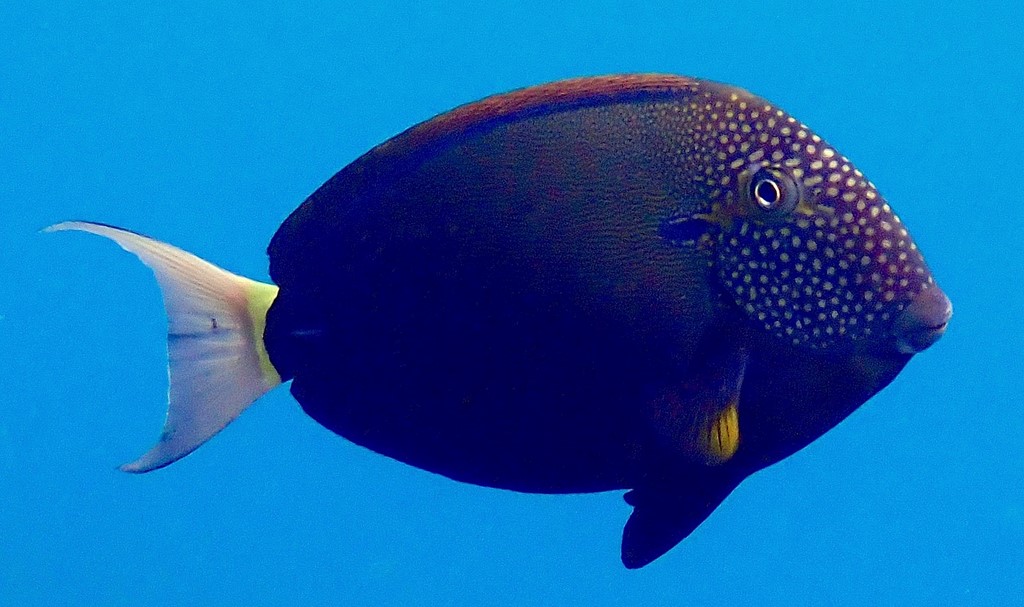ACANTHURUS MACULICEPS - (AHL, 1923)
Picture courtesy of: Aquarium Fish (Link)
Poisson-chirurgien à tête ponctuée, Spotted-face surgeonfish, Spot-face surgeon, Earbar surgeonfish, White-freckled surgeonfish, Irezuminiza, イレズミニザ, 倒吊, 頭斑刺尾鯛,
Synonyme
Hepatus maculiceps (Ahl, 1923)
-------------------------
Description
Description
Dorsal spines (total): 9; Dorsal soft rays (total): 24-26; Anal spines: 3; Anal soft rays: 22-24; Pectoral fin rays: 16-17; Gill rakers on anterior row: 19-23, on posterior row: 21-24; Adults with up to 18 upper teeth and 20 lower teeth. Body depth: 2.0-2.2 in SL; Snout convex in large adults; Caudal peduncle spine: 3.1-3.2 in HL (usually: 3.3). Caudal fin of adults lunate, the caudal concavity: 3.5-3.7 in SL. Large adults develop a distinctly convex head profile. Max. length: 40.0 cm SL. Depth range: 1 - 15 m.
Color
Body brown to grey-brown, with numerous fine pale yellow longitudinal lines, except on abdomen and chest; Upper end of gill opening with short horizontal black band, narrowly rimmed yellow, its anterior part sometimes yellow; Head and nape with numerous small, round to oblong, pale yellow or blue spots, some interconnected; Dorsal fin with thin black line at base and oblique narrow yellow bands distally; Pectoral fins with large yellow blotch distally; Peduncle spine white, socket edged black; Caudal fin with irregular narrow yellowish white bar at base and thin white margin.
Etymology
Acanthurus: from Greek, akantha = thorn, prickle, spine + from Greek, oura = tail. Referring to sharp scalpel-like scales on caudal peduncle (hence the common names surgeonfish and doctorfish).
maculiceps: from Latin, maculatus = stain, make spotted + from Latin suffix, -ceps = head. Referring to numerous white spots on head.
Original description: Hepatus maculiceps Ahl, 1923 - Type locality: Talassia, New Pomerania (Kikiwiei/Comet Harbour, New Britain, Papua New Guinea, Bismarck Sea, western Pacific, ca. 5°32'S, 149°43'E).
Distribution
Indo-West Pacific: Maldives, east to Marshall Islands and Line Islands, north to Amami Islands (southern Japan), south to Kimberley (Western Australia), Queensland (Australia), New Caledonia, Solomon Islands and Samoa; Waifs reaching Hawaiian Islands.
Biology
Inhabits clear outer reef flats and seaward reefs. Benthopelagic. Solitary or in small wide-ranging groups. Usually in schools of mixed similar species when grazing algae.
Inhabits clear outer reef flats and seaward reefs. Benthopelagic. Solitary or in small wide-ranging groups. Usually in schools of mixed similar species when grazing algae.
Last update: 4, April 2023
